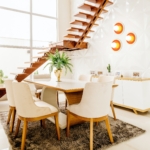The creative process behind each Tilt Limited Editions lamp is a blend of thought, discussion, experimentation and passion. It is an adventure that is both intellectual and sensory, where each step is an opportunity to push our limits, test new ideas and refine our vision of design.
1. The birth of the idea: from sketch to discussion
Everything often begins with a spontaneous idea, a concept that arises from an inspiration or an observation, whether in nature, art, or even an element of daily life. This first, fleeting idea takes shape on paper, in the form of a sketch, notes or even abstract shapes. It’s a free, almost intuitive moment, where everything is possible and creativity is given free rein. The idea can come from one of our many discussions between us, but also from the way in which a material, a color or an object sparks new thoughts in us.
Once the idea is outlined, we share it and discuss it together to refine it, enrich it and put it into perspective. It is a phase of dialogue where each proposal, each comment is taken into account. It is also a moment of co-creation, where everyone brings their expertise and ideas, whether in terms of aesthetics, technique, or ergonomics.
2. From idea to 3D design: modeling and first forms
Once the general idea is clear and we have found the direction to follow, we move on to the next step: 3D modeling. At this point, we use computer-aided design (CAD) software to bring the lamp to life more precisely. This phase allows us to test the shape, proportions, assembly of the elements, and above all to begin to visualize how the light will diffuse through the materials we have chosen.
3D modeling allows us to play with the aesthetics and functionality of the lamp: how the different parts fit together, how they adapt to technical constraints while remaining faithful to the initial idea. This step is crucial, because it allows you to move from intuition to a more concrete vision and to plan certain technical details before embarking on the following steps.
3. The first tests and models: test and adjust
Next comes the stage of models and prototypes, a phase where we materialize our ideas to see how they translate into the real world. This is where the first tensions appear: the reality of materials, shapes, manufacturing techniques, and light itself can lead to adjustments to the design. We experiment with full-size models, often using simpler or more accessible materials to test the ergonomics, balance, and visual effect of the shapes. This is an important moment when we realize if the lamp works well in the space and how it interacts with the light.
At the same time, we carry out color tests. We’ve always been big on how color transforms a room, and choosing the perfect shades is a process in its own right. We experiment with color combinations, testing different shades to see how they react to light and the environment. Some lamps are more subtle in their palette, while others are bold and vivid, but each color choice is carefully considered to achieve the desired end result.
4. Prototypes and adjustments: refining the object
Once the shape and color have been validated, we move on to creating more complete prototypes. These are near-final versions of the lamp, made with quality materials and components close to those that will be used in the final production. These prototypes are used to make last-minute adjustments: verification of manufacturing quality, robustness, ergonomics and lighting tests. This is also when we check that the lamp meets our expectations in terms of functionality, particularly in terms of light management, stability, and ease of use.
It is not uncommon for new ideas or inspirations to arise during this phase. In reality, throughout creation, our objects continue to evolve, often based on new discoveries or small developments in our tastes and desires. We always leave the door open to improvisation and spontaneous inspiration: a finishing detail, a color adjustment, a decorative addition can arise at any time. It is this flexibility and this ability to evolve that means that a Tilt Limited Editions lamp can sometimes surprise even its creators, by transforming over time.
5. The final step: launching production
Finally, when we reach the version that we consider “perfect”, the one where the balance between aesthetics, functionality and emotion is achieved, the lamp is ready for production. At that point, we move on to manufacturing small, limited series. We ensure that each lamp is manufactured in optimal conditions, while respecting our values: quality, authenticity and durability.
6. Launch and presentation: share inspiration
Once production is complete, it’s time to share our work with the world. Whether through events, exhibitions or online sales, each Tilt Limited Editions lamp is an invitation to discover a new way of understanding light. Each creation is a little adventure, a creative process that has allowed us to push our own limits while remaining faithful to our philosophy: that of designing objects that bring joy, energy and creativity in everyday life .
The creative process at Tilt is a multi-step adventure, a balance between technique and inspiration, intuition and experimentation. It is this alchemy between reflection, ideation, manufacturing and emotion that gives birth to unique lamps, which not only illuminate an interior, but also redefine its atmosphere.


